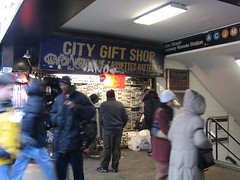Retail at WMATA stations isn't a step in the right direction for revitalization of neighborhood commercial districts in DC
 City Gift Shop. Fulton-Broadway-Nassau Subway Station, Lower Manhattan. Bridge and Tunnel Club photo.
City Gift Shop. Fulton-Broadway-Nassau Subway Station, Lower Manhattan. Bridge and Tunnel Club photo.I had been meaning to write about this, but hadn't gotten around to it, but today it came up on the Columbia_Heights e-list, because of an email from Councilmember Graham's office. CM Graham is a stalwart member of the WMATA board.
William Jordan writes:
Is this really a good approach to encouraging neighborhood serving retail and streetscape activiity along that area of Georgia Ave.? I would thing this is the opposite approach we want at this station, vs. say a Fort Totten which is more isolated from its streetscape. I can remember the arguments against continuing this type of approach at the Reeves Center at 14th & U Sts. Why would we want to bottle this energy inside of Metro on Georgia Ave. especially this type of retail? By bringing this approach to Georgia Ave. Metro is sucking potential economic and people energy from the Georgia Ave streetscape. The ideal is probably a good idea at the heavy suburban Red/Orange/Blue line stops serving the Federal Districts and similar areas.
Another person wrote saying that William is wrong. But I disagree. Here's what I wrote (slightly edited):
Actually, William is right. It's better to focus on making great streets, rather than great underground spaces. But the thing of it is, retail won't develop in most of the stations anyway, despite the strongest desires of WMATA. There aren't enough patrons-- except in the most utilized stations--to make it worthwhile for a business to pay rent and sit there tending the "store" for 12+ hours. They'll learn soon enough.
Station patrons are most likely to want to purchase convenience goods (beverages, newspapers, maybe magazines), like the stuff in Hudson News at Union Station (or Grand Central Station). The neighborhood stations aren't likely to generate much of that kind of business at all... And the profit margins aren't that great besides. You make your money on volume. And if there is no volume, well, you don't make money...
There are a couple stores that currently function as almost station-based retail, newsstands immediately adjacent to the Metro station at Farragut West (18th Street at International Square) and at Farragut North (as you enter the platform on the northeast side of Connecticut and L). Neither are huge moneymakers.
NYC has ridership vastly higher than in the DC region, as good as our system is in terms of usage. Plus you can eat on the NYC system. Not in DC.
Similarly, I think it was a mistake to focus on developing retail within the Convention Center rather than putting in serious money into rehabilitating the street level historic buildings on 9th Street between M Street and Rhode Island Avenue NW. All retail will do in the Convention Center is provide more reasons for people to not leave the cozy safe and sanitized confines that the Convention Center offers.
It's the same principle. To build better neighborhood commercial districts, focus on revitalizing the commercial districts, not adding more retail to an area that "suffers" an abundance of space, without focusing on how to strengthen the marketability and viability of the extant retail space.
____________
Note: the walkway-transitway proposal between Farragut West and Farragut North proposes a shops filled way. Even so, I think that will be difficult to make work. Stores need patrons. How many people will really walk between these two stations on an average day... I think it's a good idea, the problem is the volume of patrons needed to make it worthwhile.
Index Keywords: transit; urban-design-placemaking



0 Comments:
Post a Comment
<< Home